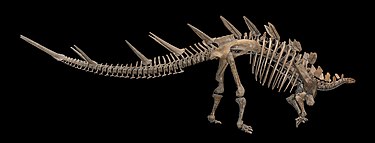|
The Jurassic (/dʒʊˈræsɪk/ juurr-ASS-ik) is a geologic period and stratigraphic system that spanned from the end of the Triassic Period 201.4 million years ago (Mya) to the beginning of the Cretaceous Period, approximately 143.1 Mya. The Jurassic constitutes the middle period of the Mesozoic Era as well as the eighth period of the Phanerozoic Eon and is named after the Jura Mountains, where limestone strata from the period were first identified.
The start of the Jurassic was marked by the major Triassic–Jurassic extinction event, associated with the eruption of the Central Atlantic Magmatic Province (CAMP). The beginning of the Toarcian Age started around 183 million years ago and is marked by the Toarcian Oceanic Anoxic Event, a global episode of oceanic anoxia, ocean acidification, and elevated global temperatures associated with extinctions, likely caused by the eruption of the Karoo-Ferrar large igneous provinces. The end of the Jurassic, however, has no clear, definitive boundary with the Cretaceous and is the only boundary between geological periods to remain formally undefined. By the beginning of the Jurassic, the supercontinent Pangaea had begun rifting into two landmasses: Laurasia to the north and Gondwana to the south. The climate of the Jurassic was warmer than the present, and there were no ice caps. Forests grew close to the poles, with large arid expanses in the lower latitudes. (Full article...) (Full article...)
Cryolophosaurus (/ˌkraɪ.oʊˌlɒfoʊˈsɔːrəs/ or /kraɪˌɒloʊfəˈsɔːrəs/; "CRY-oh-loaf-oh-SAWR-us") is a genus of large theropods known from only a single species Cryolophosaurus ellioti, known from the early Jurassic period of Antarctica. It was about 6 to 7 metres (20 to 23 ft) long and 460 kilograms (1,010 lb) in weight, making it one of the largest theropods of its time. Individuals of this species may have grown even larger, because the only known specimen probably represents a sub-adult.
Cryolophosaurus is known from a skull, a femur and other material, the skull. C. ellioti possessed a distinctive crest on its head that spanned the head from side to side. Based on evidence from related species and studies of bone texture, it is thought that this bizarre crest was used for intra-species recognition. Since its original description, the consensus is that Cryolophosaurus is either a primitive member of the Tetanurae or a close relative of that group. Cryolophosaurus was first excavated from Antarctica's Early Jurassic, Sinemurian to Pliensbachian aged Hanson Formation, formerly the upper Falla Formation, by paleontologist Dr. William Hammer in 1991. It was the first carnivorous dinosaur to be discovered in Antarctica and the first non-avian dinosaur from the continent to be officially named. The sediments in which its fossils were found have been dated at ~194 to 188 million years ago, representing the Early Jurassic Period. (see more...)
Edward Drinker Cope (July 28, 1840 – April 12, 1897) was an American paleontologist and comparative anatomist, as well as a noted herpetologist and ichthyologist. Cope distinguished himself as a child prodigy, publishing his first scientific paper at the age of nineteen. Cope later married and moved from Philadelphia to Haddonfield, New Jersey, although Cope would maintain a residence and museum in Philadelphia in his later years.
Cope had little formal scientific training, and he eschewed a teaching position for field work. He made regular trips to the American West prospecting in the 1870s and 1880s, often as a member of United States Geological Survey teams. A personal feud between Cope and paleontologist Othniel Charles Marsh led to a period of intense fossil-finding competition now known as the Bone Wars. Cope's financial fortunes soured after failed mining ventures in the 1880s. He experienced a resurgence in his career toward the end of his life before dying in 1897. Cope's scientific pursuits nearly bankrupted him, but his contributions helped to define the field of American paleontology. He was a prodigious writer, with 1,400 papers published over his lifetime, although his rivals would debate the accuracy of his rapidly published works. He discovered, described, and named more than 1,000 vertebrate species including hundreds of fishes and dozens of dinosaurs. His proposals on the origin of mammalian molars and for the gradual enlargement of mammalian species over geologic time ("Cope's Law") are notable among his theoretical contributions. (see more...)

Do you have a question about Abyssal/Portal:Jurassic that you can't find the answer to? Consider asking it at the Wikipedia reference desk. Epochs - Early Jurassic - Middle Jurassic - Late Jurassic Landmasses - Baltica - Gondwana - Laurentia - Siberia Fossil sites - Beecher's Trilobite Bed - Walcott–Rust quarry Researchers - Charles Emerson Beecher - Charles Lapworth - Charles Doolittle Walcott Featured Mesozoic articles - Bone Sharps, Cowboys, and Thunder Lizards - Bone Wars - Edward Drinker Cope - Geology of the Capitol Reef area - Geology of the Death Valley area -Geology of the Grand Canyon area - Geology of the Zion and Kolob canyons area Good Mesozoic articles - Chitinozoan - Coal ball - Dimetrodon - History of paleontology - Evolutionary history of life - Ornatifilum - Opabinia - Paleontology- Schinderhannes - Small shelly fauna - Temnospondyli - Tiktaalik - Waptia The following Wikimedia Foundation sister projects provide more on this subject:
|




















